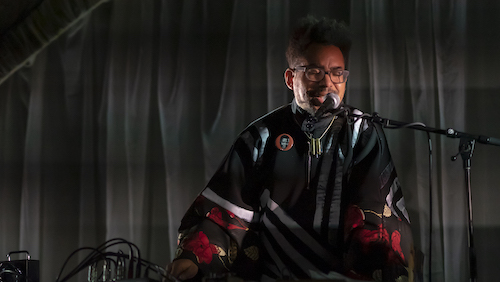Apr 2, 2024 12:59 PM
Saxophonist, Sonic Explorer Casey Benjamin Dies at 45
Casey Benjamin, the alto saxophonist, vocalist, keyboardist and producer who stamped his distinctive sounds on the…

Damon Locks leads the 15-piece Black Monument Ensemble on Where Future Unfolds.
(Photo: Chris Hershman)Fantastical black-nationalist jazz now is back in vogue, thanks to the likes of Shabaka Hutchings, Nicole Mitchell, Christian Scott aTunde Adjuah and Kamasi Washington. Their music vibrates with a heady blend of Afrofuturism, sociopolitical intent and idiomatic hybridism that often incorporates 1960s free-jazz spiritualism, soul music, hip-hop and electronica.
You now can add Chicago’s Damon Locks to that distinguished roster.
Chicago long has proved to be a mothership for the development of this type of ingenuity: The Windy City is where Herman Poole Blount reinvented himself as Sun Ra during the 1950s; it’s where the Association for the Advancement of Creative Musicians formed in the mid-’60s; it’s where AACM member Phil Cohran electrified the kalimba, an instrument that in the hands of Maurice White became a signature sound for Earth, Wind & Fire; and it’s where pioneering DJs Steve Hurley, Frankie Knuckles and Chip E. took notes from Sun Ra’s “Space Is The Place” mantra, and laid the blueprint for the house music scene in the early 1980s, following the racist and homophobic backlash to disco.
Chicago label International Anthem has been consolidating and curating new offshoots of that multilayered, intersecting musical legacy with CD and vinyl releases of jazz-hybrid mavericks like drummer Makaya McCraven, clarinetist/vocalist Angel Bat Dawid, guitarist Jeff Parker, cornetist Ben Lamar Gay and trumpeter Jaimie Branch.
On his soul-stirring IA release, Where Future Unfolds, Locks crafts soundscapes and plays tiny percussion with his 15-piece Black Monument Ensemble, captured live during a 2018 Red Bull Music Festival performance at Chicago’s Garfield Park Conservatory. Locks, though, is a wildly imaginative polymath, a visual artist, DJ, sound sculptor and educator—and former bandmate of Fred Armisen as a member of Trenchmouth, a group that issued a handful of albums during the ’90s. He’s also led The Eternals through LP-length efforts since 2000, melding dub and indie styles.
But his latest effort takes considerable cues from Eddie Gales’ Ghetto Music, Funkadelic’s America Eats Its Young and Public Enemy’s Fear Of A Black Planet as thematic elements of black nationalism, escapism and cultural displacement seep into the music—as do the cyclical acts of destruction and restoration.
That last motif comes loud and clear from the LP’s opener, “Statement Of Intent/Black Monument,” on which Locks intones, “Knowing what we know now/ The mind searches for reconciliation/ Arches and angles that don’t meet/ Materials that bow and shutter/ Tall and broad/ These things cast shadows/ Invaluable structures that buckle as they pivot” amid a buzzing nest of small bells. As Locks continues, accelerating his words with urgency, Dana Hall underscores the incantation with lacerating drum beats that eventually coalesce into a volatile improvisation—all of which could provide the soundtrack for the recent removal of various Confederate statues in the South.
Other explicit evocations concerning protest-fueled annihilation and community rebuilding occur on the disquieting “The Future?,” where Dawid’s serpentine clarinet passages stretch across a blaring sonic terrain of bombastic drum fills, pinging percussion and gloomy electronic flourishes, and the more optimistic “Rebuild A Nation,” which features young singer Rayna Golding leading a small gospel choir atop haunting conga and shaker patterns.
Even with its bare-bones instrumentation of vocals, percussion, drums and sound collage, Where Future Unfolds exudes a claustrophobic, anxiety-ridden sensibility—fitting for music that addresses concerns of deep-seated institutionalized racism, and sociopolitical and economic disenfranchisement. Through solemn vocal harmonies, lamenting melodies, and poignant and political lyrics, Locks deftly articulates the weariness black Americans suffer from the enduring Sisyphus syndrome of making incremental strides for equal rights—which all too often are offset by enormous setbacks.
Indeed, tracks like the undulating “Sounds Like Now,” the gospel-laden “Solar Power” and the dirge-like “From A Spark To A Fire” can overwhelm in their mournful sentiments and often lumbering tempos. Searing lead single “The Colors That You Bring,” with its hip-hop-meets-1970s Motown beat, dramatically sampled strings and Dawid’s bass clarinet riffs, is Where Future Unfolds at its brightest. Sill, the song conjures an image of a rainbow barely piercing through dark, rumbling clouds, fighting for space. DB

Benjamin possessed a fluid, round sound on the alto saxophone, and he was often most recognizable by the layers of electronic effects that he put onto the instrument.
Apr 2, 2024 12:59 PM
Casey Benjamin, the alto saxophonist, vocalist, keyboardist and producer who stamped his distinctive sounds on the…

“He’s constructing intelligent musical sentences that connect seamlessly, which is the most important part of linear playing,” Charles McPherson said of alto saxophonist Sonny Red.
Feb 27, 2024 1:40 PM
“I might not have felt this way 30 to 40 years ago, but I’ve reached a point where I can hear value in what people…

Albert “Tootie” Heath (1935–2024) followed in the tradition of drummer Kenny Clarke, his idol.
Apr 5, 2024 10:28 AM
Albert “Tootie” Heath, a drummer of impeccable taste and time who was the youngest of three jazz-legend brothers…

“Both of us are quite grounded in the craft, the tradition and the harmonic sense,” Rosenwinkel said of his experience playing with Allen. “Yet I felt we shared something mystical as well.”
Mar 12, 2024 11:42 AM
“There are a few musicians you hear where, as somebody once said, the molecules in the room change. Geri was one of…

Henry Threadgill performs with Zooid at Big Ears in Knoxville, Tennessee.
Apr 9, 2024 11:30 AM
Big Ears, the annual four-day music celebration that first took place in 2009 in Knoxville, Tennessee, could well be…